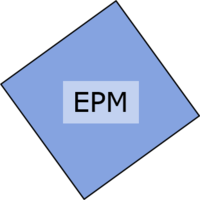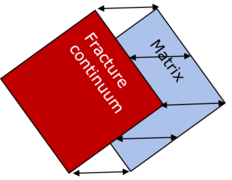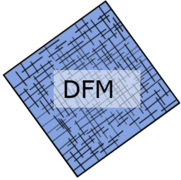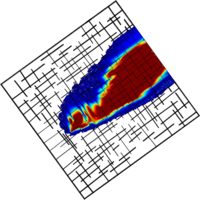Difference between revisions of "Model concepts"
m |
m |
||
| Line 2: | Line 2: | ||
Model concepts of different complexity have been developed and are used for the modeling of flow and transport in fractured porous media. Here is an overview of the major groups. | Model concepts of different complexity have been developed and are used for the modeling of flow and transport in fractured porous media. Here is an overview of the major groups. | ||
| + | [[File:EPM_square.png|x200px|Equivalent porous medium approach.|frameless|right|Equivalent porous medium approach.]] | ||
=== Equivalent porous-medium model (EPM) === | === Equivalent porous-medium model (EPM) === | ||
<!-- [[File:EPM_square.png|x180px|Equivalent porous medium approach.|Framed|right|Equivalent porous medium approach.]] --> | <!-- [[File:EPM_square.png|x180px|Equivalent porous medium approach.|Framed|right|Equivalent porous medium approach.]] --> | ||
| − | |||
The equivalent porous medium model is a standard model concept for porous media with parameters averaged over control volumes. | The equivalent porous medium model is a standard model concept for porous media with parameters averaged over control volumes. | ||
Usually, a flow model and a transport model are solved. | Usually, a flow model and a transport model are solved. | ||
| Line 16: | Line 16: | ||
<br clear=all> | <br clear=all> | ||
| + | [[File:DualContinuumSchematics.png|x180px|Dual continuum approach.|frameless|right|Dual continuum modeling approach.]] | ||
=== Dual-continuum model === | === Dual-continuum model === | ||
| − | + | The dual-continuum model, often also called dual-porosity model, uses two continua, the matrix and the fracture continuum. | |
Balance equations for flow and transport are formulated for each continuum, and the two continua have the same dimensionality (e.g. 3D fracture continuum and 3D matrix continuum). | Balance equations for flow and transport are formulated for each continuum, and the two continua have the same dimensionality (e.g. 3D fracture continuum and 3D matrix continuum). | ||
The basic concept is described in Gerke and Van Genuchten (1993). | The basic concept is described in Gerke and Van Genuchten (1993). | ||
| Line 27: | Line 28: | ||
<br clear=all> | <br clear=all> | ||
| + | [[File:DFM.png|Discrete-fracture approach.|x180px|frameless|right|Discrete-fracture approach.]] | ||
=== Discrete-fracture model (DFM) === | === Discrete-fracture model (DFM) === | ||
| − | |||
The discrete-fracture model (DFM) is the most detailed approach for fracture flow and transport modeling. | The discrete-fracture model (DFM) is the most detailed approach for fracture flow and transport modeling. | ||
The (major) fractures are explicitly discretized and embedded in the porous matrix. | The (major) fractures are explicitly discretized and embedded in the porous matrix. | ||
| Line 38: | Line 39: | ||
For good simulation results, a very fine grid resolution at the fracture-matrix interface is required. | For good simulation results, a very fine grid resolution at the fracture-matrix interface is required. | ||
| − | [[File:Plume DFM 8yrs highKcontrast-50ug.png|x200px|none|thumb|Example of a DFM | + | [[File:Plume DFM 8yrs highKcontrast-50ug.png|x200px|none|thumb|Example of a transport simulation with a DFM showing PCE concentrations.]] |
<!-- | <!-- | ||
Revision as of 10:25, 8 February 2017
Contents
Model concepts
Model concepts of different complexity have been developed and are used for the modeling of flow and transport in fractured porous media. Here is an overview of the major groups.
Equivalent porous-medium model (EPM)
The equivalent porous medium model is a standard model concept for porous media with parameters averaged over control volumes. Usually, a flow model and a transport model are solved. The flow field can be computed with Darcy's law. The contaminant transport is described by the advection-dispersion equation, where different processes like sorption and degradation can be included.
Due to its simplicity and its low computational effort, the EPM model is widely used, also for fractured geologies.
However, fractures are not explicitly modeled.
Instead, bulk hydraulic conductivities and effective diffusion or dispersion coefficients are used.
This has as consequence that flow and transport in fractures and the exchange with the matrix cannot be correctly reproduced, leading to poor predictions for transport in dual-continuum aquifers.
Dual-continuum model
The dual-continuum model, often also called dual-porosity model, uses two continua, the matrix and the fracture continuum.
Balance equations for flow and transport are formulated for each continuum, and the two continua have the same dimensionality (e.g. 3D fracture continuum and 3D matrix continuum).
The basic concept is described in Gerke and Van Genuchten (1993).
Different parameters are used in the continua, f.e. porosities and conductivities specific for the fractures and for the matrix.
The continua are coupled via exchange fluxes using the source and sink terms in the balance equations, allowing for exchange of water and substances between fractures and matrix.
For that purpose, the exchange fluxes and exchange coefficient have to be defined and the choice is not clear.
The exchange coefficients are usually used as fitting parameters.
Concepts with more than two continua (f.e. Multiple INteracting Continua approach, MINC) have also been developed.
Discrete-fracture model (DFM)
The discrete-fracture model (DFM) is the most detailed approach for fracture flow and transport modeling. The (major) fractures are explicitly discretized and embedded in the porous matrix. Usually, the fractures are resolved with one dimension less than the matrix (e.g. matrix is a 3D volume, the fractures are 2D planes). The fractures have to be characterized by properties like aperture, length, spacing, main orientation. Fractures and matrix are usually coupled at the fracture-matrix interface by flux continuity and continuity of the primary variables (hydraulic head, concentration). This is the most physically-based approach and the exchange between fractures and matrix happens naturally. However, the numerical efforts are also highest for this model, especially for complex fracture networks with many fractures. For good simulation results, a very fine grid resolution at the fracture-matrix interface is required.
Random-walk methods
Return to Content



